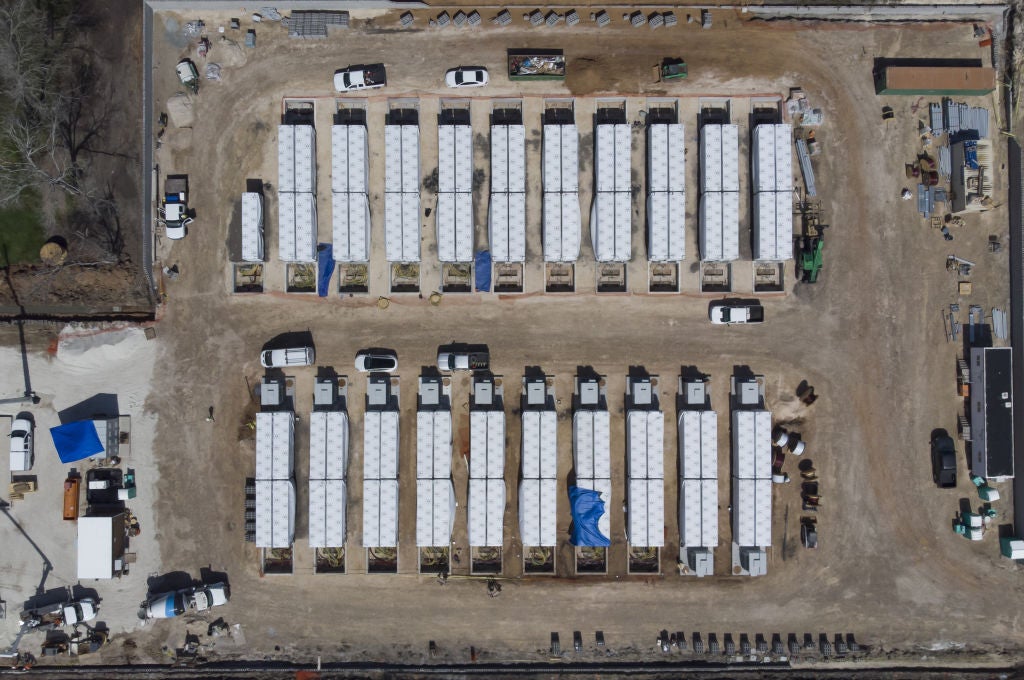For years it has been a key question for energy policymakers: how to balance the electricity grid when it is majority-powered by variable renewables such as solar and wind? Pumped hydropower, green hydrogen, peaker plants paired with carbon capture and storage and nuclear power continue to be mooted as solutions to this problem.
With the UK, US and EU now all planning to fully decarbonise their power grids in little more than a decade, this question is no longer theoretical but a matter of urgency. Indeed, wind and solar had a larger combined share of EU power generation than natural gas for the first time in 2022, with nations including Germany, Spain, Ireland and Denmark generating more than 30% of their power from solar and wind that year.

Pumped hydropower continues to deliver 90% of global grid-scale storage, says the International Energy Agency (IEA). However, the area now drumming up the biggest policy interest is grid-scale batteries, a technology the IEA anticipates will deliver the largest growth in battery storage capacity worldwide in the coming years.
Just a few years ago, grid-scale battery storage was widely deemed too expensive to ever be rolled out at significant scale. However, the price of electrochemical battery storage has plummeted, from $1,200 per kilowatt-hour (kWh) of lithium-ion (Li-ion) battery storage in 2010 to $151 in 2022, according to research company BloombergNEF (BNEF).
[Keep up with Energy Monitor: Subscribe to our weekly newsletter]
Countries around the world are now ramping up their battery storage. China plans to install more than 30GW of energy storage by 2025, an eightfold increase on what it currently has. In Germany, innovation auctions are rewarding the pairing of renewables with storage. The 2021 and 2022 auctions together accounted for more than 1GW of new battery storage added to the grid.

US Tariffs are shifting - will you react or anticipate?
Don’t let policy changes catch you off guard. Stay proactive with real-time data and expert analysis.
By GlobalDataThe US Inflation Reduction Act also includes federal tax credits for stand-alone storage, which has boosted the competitiveness of grid-scale storage projects in that market.
The IEA anticipates the technology being a key pillar in its net zero by 2050 pathway, with global battery storage growing from 18GW in 2020 to 610GW in 2030, and 3,100GW in 2050.
The upsurge in interest in batteries is reflected in the latest grid-scale battery data from GlobalData, Energy Monitor’s parent company. By the end of 2023, worldwide grid-scale electrochemical battery storage will have more than doubled in three years to 37GW, according to GlobalData.
By 2030, battery storage will have hit 354GW. BNEF is even more optimistic, anticipating 411GW by 2030.
In the US alone, some 4GW of battery storage was added in 2022, nearly matching the 4.7GW that had been installed in previous years. California and Texas accounted for 90% of US battery installations, according to the Energy Information Administration, bringing online 2.4GW and 1.3GW, respectively, in 2022.
Massive battery projects each with more than 500MW power capacity are being built in Australia, China, the US and the UK.
However, neither BNEF nor GlobalData’s projections are yet large enough to meet the 610GW of grid-scale storage the IEA says must be installed by 2030 to be on track for net zero. Nevertheless, such projections have a history of underestimating the speed of the energy transition: BNEF itself more than doubled its estimates for energy storage deployments from 2025 to 2030 across Europe in 2022 compared with previous forecasts.
One factor that may create a bottleneck, though, is supplies of lithium, the price of which remains nearly five-times greater than it was at the start of 2020.
In 2022, raw material prices led to the first year-on-year increase in Li-ion battery pack prices since 2010, as tracked by BNEF. The price increased by 7% per kWh compared with the previous year.
Once raw material prices stabilise, however, it is expected that the price of batteries will once again continue declining.
"We expect battery prices to remain in the same range in 2023, and from 2024, we are going to start to see a decline again," said Harminder Singh, director of electricity research at GlobalData, in a recent GlobalData webinar. "But that all still depends on how commodity prices behave in the future."



